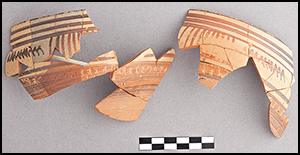Article contents
The early history of the Greek alphabet: new evidence from Eretria and Methone
Published online by Cambridge University Press: 15 September 2016
Abstract

Inscriptions on new archaeological finds in the Aegean, examined alongside linguistic evidence relating to Greek and Phrygian vowels, are here used to explore the origins and spread of the Greek alphabet. The ‘invention’ of vowels happened just once, with all of the various Greek, Phrygian and Italic alphabets ultimately deriving from this single moment. The idea spread rapidly, from an absence of writing in the ninth century BC to casual usage, including jokes, by 725 BC. The port of Methone in the northern Aegean emerges as a probable candidate for the site of origin. A place where Greeks and Phoenicians did business together, with international networks; was this where Semitic, Greek and Phrygian letters first coalesced?
- Type
- Research
- Information
- Copyright
- Copyright © Antiquity Publications Ltd, 2016
References
- 13
- Cited by




